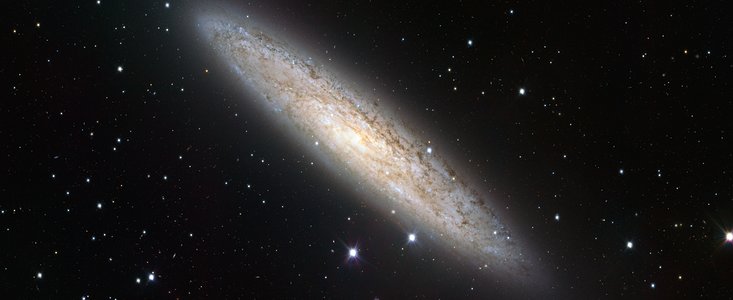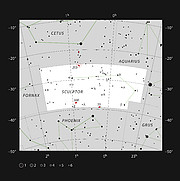Persbericht
Een sterrenstelsel dat blaakt van de nieuwe sterren
VLT Survey Telescope maakt groothoekopname van NGC 253
15 december 2011
De VLT Survey Telescope (VST) heeft de schoonheid van het nabije spiraalstelsel NGC 253 vastgelegd. Het nieuwe portret is waarschijnlijk de meest detailrijke groothoekopname van dit object en zijn omgeving die ooit is gemaakt. Het toont aan dat de VST, de nieuwste telescoop van de ESO-sterrenwacht op Paranal, een groot beeldveld kan combineren met een indrukwekkende beeldscherpte.
NGC 253 bevindt zich op een afstand van ongeveer 11,5 miljoen lichtjaar in het zuidelijke sterrenbeeld Sculptor (Beeldhouwer). Vaak wordt hij simpelweg het Sculptorstelsel genoemd, maar hij heeft ook diverse bijnamen, waaronder ‘Zilveren Dollarstelsel’. NGC 253 is al met een verrekijker goed te zien, want net als het grote buurstelsel van onze Melkweg, het Andromedastelsel, behoort hij tot de helderste sterrenstelsels aan de hemel.
Astronomen hebben vastgesteld dat er in NGC 253 veel stervormingsactiviteit plaatsheeft, waardoor hij tot de ‘starburst’-stelsels kan worden gerekend [1]. De vele heldere klonten waarmee het stelsel bezaaid is, zijn stellaire kraamkamers waarin pasgeboren hete sterren schitteren. De straling van deze blauwwitte reuzenbaby’s brengt de omringende wolken van waterstofgas aan het gloeien (groen op deze foto).
Dit nabije spiraalstelsel is in 1783 ontdekt door de Duits-Britse astronome Caroline Herschel, de zus van de beroemde astronoom William Herschel, die eigenlijk naar kometen zocht. De Herschels zouden verrukt zijn geweest over deze scherpe, detailrijke VST-opname van NGC 253.
De nieuwe foto van NGC 253 is gemaakt tijdens de wetenschappelijke verificatiefase van de VST – de fase waarin de prestaties van de telescoop worden getest voordat hij volledig operationeel wordt. De VST-gegevens zijn gecombineerd met infraroodopnamen van VISTA (eso0949) om de jonge generaties van sterren in NGC 253 te kunnen herkennen. De foto is meer dan 12.000 pixels breed en door de combinatie van de uitmuntende hemelomstandigheden op ESO’s Paranal-sterrenwacht en de verfijnde telescoopoptiek zijn de sterbeeldjes over het hele beeldveld scherp.
De VST is een 2,6-meter surveytelescoop met een beeldveld van één graad – tweemaal de breedte van de volle maan [2]. Het VST-programma is een samenwerkingsverband tussen het INAF-Osservatorio Astronomico di Capodimonte in Napels (Italië) en ESO (eso1119). De 268-megapixel camera OmegaCAM in het hart van de VST is ontworpen om de hemel snel en gedetailleerd vast te leggen. VST is de grootste telescoop ter wereld die exclusief ontworpen is voor het in zichtbaar licht in kaart brengen van de hemel. Daarbij werkt hij samen met ESO’s infrarood-surveytelescoop VISTA, die ook op Paranal staat.
Bij nadere inspectie toont deze nieuwe foto, behalve de stervormingsgebieden in de spiraalarmen van NGC 253, ook een rijke tapisserie van veel verder weg gelegen sterrenstelsels.
Noten
[1] Meer details over NGC 253 zijn ontdekt met ESO’s Very Large Telescope (VLT) en de Hubble-ruimtetelescoop van NASA en ESA. Deze instrumenten hebben in 2009 laten zien dat in het centrum van NGC 253 een superzwaar zwart gat schuilgaat, dat qua eigenschappen vergelijkbaar is met het zwarte gat in het centrum van de Melkweg (eso0902).
[2] De hier getoonde foto is een beetje bijgesneden; het volledige beeldveld van de VST is dus iets groter.
Meer informatie
ESO, de Europese Zuidelijke Sterrenwacht, is de belangrijkste intergouvernementele sterrenkundeorganisatie in Europa, en het meest productieve astronomische observatorium ter wereld. Zij wordt ondersteund door vijftien landen: België, Brazilië, Denemarken, Duitsland, Finland, Frankrijk, Italië, Nederland, Oostenrijk, Portugal, Spanje, Tsjechië, het Verenigd Koninkrijk, Zweden en Zwitserland. ESO voert een ambitieus programma uit, gericht op het ontwerp, de bouw en het beheer van krachtige grondobservatoria die astronomen in staat stellen om belangrijke wetenschappelijke ontdekkingen te doen. ESO speelt ook een leidende rol bij het bevorderen en organiseren van samenwerking op sterrenkundig gebied. ESO beheert drie waarnemingslocaties van wereldklasse in Chili: La Silla, Paranal en Chajnantor. Op Paranal staan ESO’s Very Large Telescope (VLT), de meest geavanceerde optische sterrenwacht ter wereld, en twee surveytelescopen: VISTA werkt in het infrarood en is de grootste surveytelescoop ter wereld en de VLT Survey Telescope is de grootste telescoop die uitsluitend is ontworpen om de hemel in zichtbaar licht in kaart te brengen. Ook is ESO de Europese partner van de revolutionaire telescoop ALMA, het grootste sterrenkundige project van dit moment. Daarnaast bereidt ESO momenteel de bouw voor van de Europese Extremely Large optische/nabij-infrarood Telescope (E-ELT), een telescoop van de 40-meterklasse die ‘het grootste oog op de hemel’ ter wereld zal worden.
Links
Contact
Drs. Marieke Baan
Nederlandse Onderzoekschool voor Astronomie (NOVA)
Amsterdam, Nederland
Tel: +31205257480
E-mail: h.m.baan@uva.nl
Massimo Capaccioli
University of Naples Federico II and INAF-Capodimonte Astronomical Observatory
Naples, Italy
Tel: +39 081 557 5601
Mob: +39 335 677 6940
E-mail: capaccioli@na.infn.it
Richard Hook
ESO, La Silla, Paranal, E-ELT and Survey Telescopes Public Information Officer
Garching bei München, Germany
Tel: +49 89 3200 6655
Mob: +49 151 1537 3591
E-mail: rhook@eso.org
Over dit bericht
| Persberichten nr.: | eso1152nl |
| Naam: | NGC 253 |
| Type: | Local Universe : Galaxy : Activity : Starburst |
| Facility: | VLT Survey Telescope |
| Instruments: | OmegaCAM |





